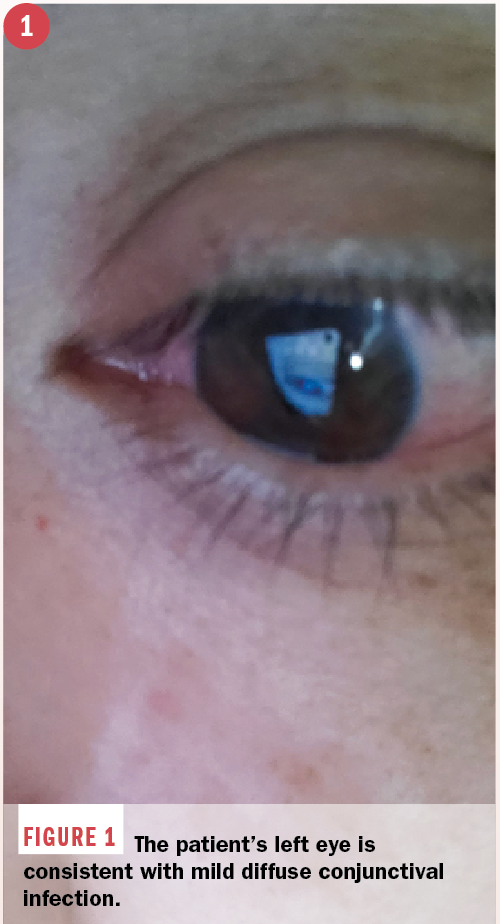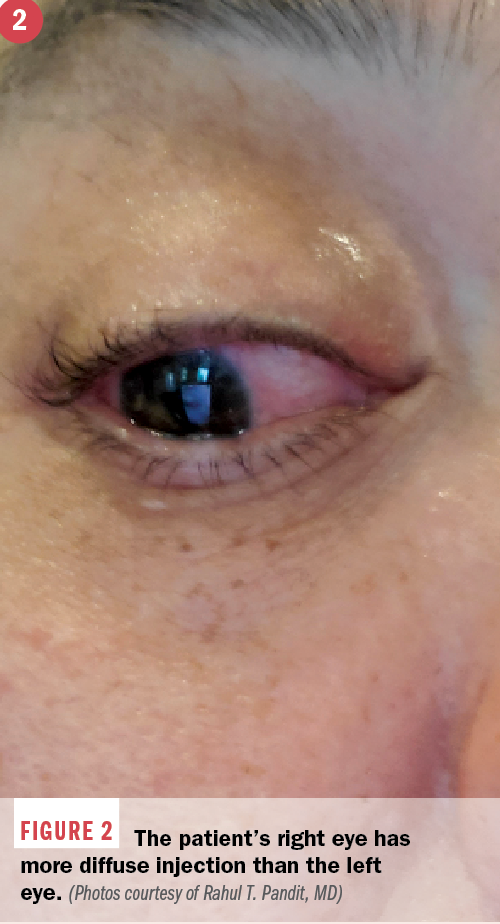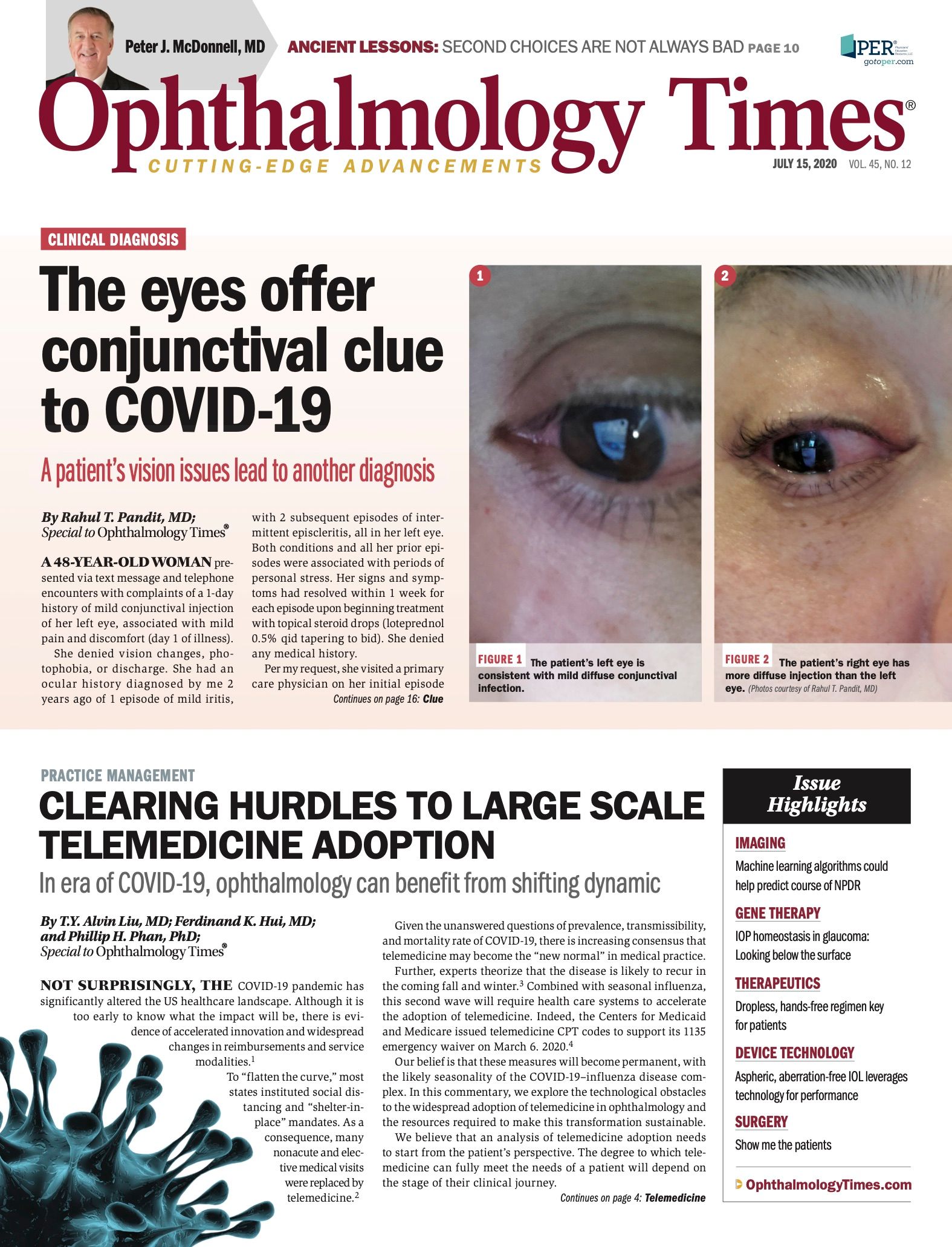Publication
Article
Digital Edition
The eyes offer conjunctival clue to COVID-19
Author(s):
A patient's vision loss leads to another diagnosis
Special to Ophthalmology Times®
A 48-year-old woman presented via text message and telephone encounters with complaints of a 1-day history of mild conjunctival injection of her left eye, associated with mild pain and discomfort (day 1 of illness).
She denied vision changes, photophobia, or discharge. She had anocular history diagnosed by me 2 years ago of 1 episode of mild iritis, with 2 subsequent episodes of intermittent episcleritis, all in her left eye. Both conditions and all her prior episodes were associated with periods of personal stress.
Related: New molecule for allergic conjunctivitis makes debut
Her signs and symptoms had resolved within 1 week for each episode upon beginning treatment with topical steroid drops (loteprednol 0.5% qid tapering to bid). She denied any medical history.
Per my request, she visited a primary care physician on her initial episode for a physical exam, which was reportedly normal. Baseline routine blood work as well as a basic autoimmune profile were reported as normal.
Due to countywide, emergency stay-at-home orders resulting from the COVID-19 pandemic, instituted 2 days prior to her symptom onset, an in-office formal exam in the clinic was deferred.
As a result, she communicated by phone, sending photos via text. Her vision appeared stable and equal between the 2 eyes when testing herself in her surroundings. Her photo was consistent with mild diffuse conjunctival injection of the left eye. (Figure 1.)

There was no sign of perilimbal injection. There appeared to be mild watery discharge and the corneal light reflex appeared normal. Her right eye showed no abnormalities.
Related: Conjunctival melanoma: Unlocking mysteries of disease
At this point, the diagnosis was possible inflammatory ocular disease based on her history. I gave her the option to treat with a topical NSAID or steroid eye drop, but she deferred in favor of monitoring.
Three days later (day 4 of illness), she complained of contralateral right eye injection greater than the left, with minimal improvement of her left eye symptoms. The right eye also exhibited mild foreign body sensation and pain, but no photophobia or vision changes.

A photo of her right eye (Figure 2) revealed more diffuse injection than in her left eye. She denied any other symptoms, but upon direct questioning conceded to a 1-day history of mild nasal congestion, consistent with a history of seasonal allergic rhinitis.
I requested a video chat, to which she agreed. Using consumer videoconferencing technology, she was able to focus the camera on her eyes while retracting first her right then her left lower eyelid, revealing mild inferior conjunctival injection and an irregular light reflex off the inferior palpebral conjunctiva in both eyes.
Because of my concern for follicular conjunctivitis and her history of nasal congestion, I inquired into her social history and exposure to severe acute respiratory syndrome coronavirus 2 (SARS-CoV-2). She lived with her son and brother, but did not know of any specific exposure.
Due to the limitations in quantities of available diagnostic testing and a true understanding of the extent and spread of SARS-CoV-2, I felt she might be showing signs of what has been described as COVID-19 conjunctivitis.1-3
In her case, however, the ocular symptoms were the initial presentation, further confounded by a history of ocular inflammatory disease in 1 eye. Nevertheless, I urged her to obtain a COVID-19 test.
Related: COVID-19 implicated in conjunctivitis
The traditional means of obtaining tests, whether through the patient’s county health department facility or private hospital laboratories, would require screening positive for more traditional symptoms, including fever and cough.
With my guidance, she entered her clinical information on her county’s COVID-19 screening website but was denied a test due to lack of traditional symptoms.
At this point, I suggested she directly call the county health department in charge of COVID-19 testing and report the history as above. With some hesitation, I also suggested she indicate that she had experienced a mild cough and possible fever.
As a result, she was able to qualify to receive a test and was added to a queue for testing the following morning (the earliest slot they could provide).
The patient obtained a nasopharyngeal swab test in the drive-through county facility on day 6 of illness. Seven days later (day 13 of illness), she received a positive SARS-CoV-2 result.
Related: Hyperglycemia predicts death in COVID-19 patients
During this time, her ocular symptoms slowly resolved, but interestingly, on day 10 of illness, she did develop anosmia, which resolved the following day as did her nasal congestion. No other COVID-19 related symptoms were present.
As a result of a positive diagnosis, the patient maintained quarantine for 14 days from the test date (7 days after her result returned), which may have helped avoid further spread of the virus.
In keeping with usual county department protocols, her contacts were notified and those of concern were tested as well. The patient was very grateful to me for helping her obtain a correct diagnosis and enabling her to undertake the appropriate precautions that may have helped prevent illness among her family and friends.
At the outset of the pandemic it was not possible to fully characterize the various clinical presentations of the disease, due to the inability to test patients at desirable levels.
As we have learned more over time, it is evident the virus can present with nontraditional symptoms alone, as well as be present in asymptomatic patients.
Related: Researchers eye cure, diagnostics for adenoviral conjunctivitis

Conjunctivitis as a presenting complaint has been suggested based on the nature of the virus, but has not been definitely reported.4-5
The lesson for me from this case was that if I am strongly suspicious of a particular diagnosis, I may have to counsel a patient in a manner that will obtain for them the level of care needed to help avoid further complications to themselves or others in their community.
The contrary argument is that a negative test in this patient’s case could have resulted in a waste of valuable county resources. That, I believe, is where a high degree of suspicion and the strength of clinical judgment must determine one’s course of action.
About the author
Rahul T. Pandit, MD
p: 713/441-8843
Dr Pandit has no financial disclosures related to this content.
Rahul T. Pandit, MD, is the medical director, Houston Methodist Hospital Ophthalmology Operating Room, and an associate professor of clinical ophthalmology, Weill Cornell Medicine, at Houston Methodist Blanton Eye Institute in Texas.
---
References
1. Seah IYJ, Anderson DE, Kang AEZ, et al. Assessing viral shedding and infectivity of tears in coronavirus disease 2019 (COVID-19) patients. Ophthalmology. Published online March 24, 2020. doi:10.1016/j.ophtha.2020.03.026
2. Xia J, Tong J, Liu M, Shen Y, Guo D. Evaluation of coronavirus in tears and conjunctival secretions of patients with SARS-CoV-2 infection. J Med Virol. 2020;92(6):589-594. doi:10.1002/jmv.25725
3. Chen L, Liu M, Zhang Z, et al. Ocular manifestations of a hospitalised patient with confirmed 2019 novel coronavirus disease. Br J Ophthalmol. 2020;104(6):748-751. doi:10.1136/bjophthalmol-2020-316304
4. Seah I, Agrawal R. Can the coronavirus disease 2019 (COVID-19) affect the eyes? a review of coronaviruses and ocular implications in humans and animals. Ocul Immunol Inflamm. 2020;28(3):391-395. doi:10.1080/09273948.2020.1738501
5. Li JPO, Lam DSC, Chen Y, Ting DSW. Novel coronavirus disease 2019 (COVID-19): the importance of recognising possible early ocular manifestation and using protective eyewear. Br J Ophthalmol. 2020;104:297-298. doi: 10.1136/bjophthalmol-2020-315994.

Newsletter
Don’t miss out—get Ophthalmology Times updates on the latest clinical advancements and expert interviews, straight to your inbox.





